View in other NatureServe Network Field Guides
NatureServe
Montana
Utah
Wyoming
Idaho
Wisconsin
British Columbia
South Carolina
Yukon
California
New York
Darksided Cutworm - Euxoa messoria
Other Names:
Reaper Dart Moth
General Description
The dark-sided cutworm (
Euxoa messoria) is a medium-size (32-36 mm wingspan) brownish-grey moth. The male antennae are strongly biserrate and bifasculate, and the female antennae are simple. The head and thorax are even grey-brown without a contrasting prothoracic collar. The basal, antemedian and postmedian lines on the forewings are usually well marked and doubled, the later narrowly toothed at the veins. The orbicular and reniform spots are well defined, with the orbicular being a large oval. A median line or shade is often present. The terminal area is narrowly darker than the remainder of the wing. The fringe is concolorous with the wing. The hindwing is white in the male with shading to light smoky-brown on the margin, and more extensively dark-shaded in females. There is a small discal dot, the veins are narrowly lined with brown scales, and the fringe is mostly white (Anweiler 2003, Crumb 1956, and Lafontaine 1987).
The larvae has longitudinal pale brown and dark brown stripes (Powell and Opler 2009).
Phenology
Adults have been collected in the province of Alberta in mid July through late September, with the peak in late August. There is one generation per year, with the eggs over wintering in the soil. The larvae are climbing cutworms, sometimes damaging small trees and becoming pests on various crops. The larvae are active in spring and early summer. The prepupal period is reported to be variable in length (Anweiler et al. no date).
Species Range
Montana Range
Range Descriptions
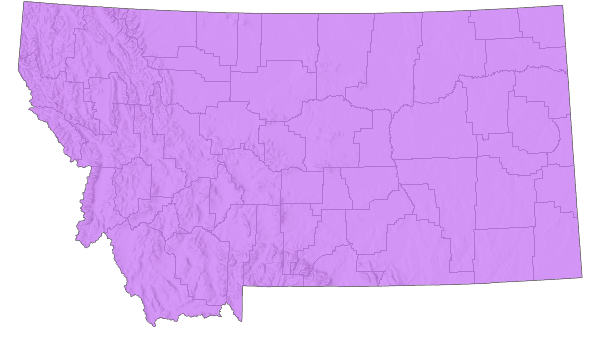
 Native
Native
Range Comments
The dark-sided cutworm is found from Newfoundland west to Yukon, south to Virginia and Missouri in the east, and New Mexico, Arizona and California in the west (Anweiler et al. no date).
Observations in Montana Natural Heritage Program Database
Number of Observations: 24
(Click on the following maps and charts to see full sized version)
Map Help and Descriptions
Relative Density
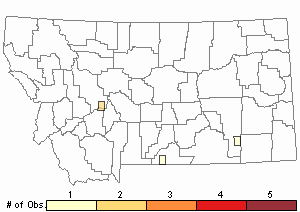
Recency
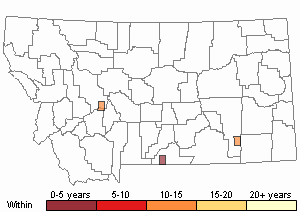
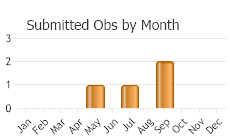
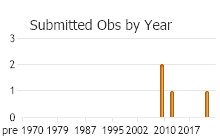
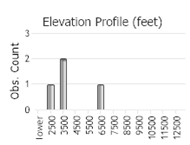 (Observations spanning multiple months or years are excluded from time charts)
(Observations spanning multiple months or years are excluded from time charts)
Habitat
Open areas such as grasslands, cultivated areas and clearings (Anweiler et al. no date).
Food Habits
The larvae prefer broad-leaved herbaceous plants and small trees, but occasionally feed on several kinds of grasses. The larva of E. messoria are a pest of apple trees, cultivated vegetables and flowers, and a wide variety of other plants (Powell and Opler 2009).
Stewardship Responsibility
References
- Literature Cited AboveLegend:
 View Online Publication
View Online Publication Crumb, S.E. 1956. The larvae of the Phalaenidae [=Noctuidae]. U.S.D.A. Tech. Bull. No. 1135. 356 pp.
Crumb, S.E. 1956. The larvae of the Phalaenidae [=Noctuidae]. U.S.D.A. Tech. Bull. No. 1135. 356 pp. Lafontaine, J.D. 1987. Noctuoidea, Noctuidae (Part): Fascicle 27.2: Noctuinae (Part-Euxoa). The Moths of America North of Mexico (Lepidoptera). E. W. Classey Ltd. and R. B. D. Publications, London, England. 237 pp.
Lafontaine, J.D. 1987. Noctuoidea, Noctuidae (Part): Fascicle 27.2: Noctuinae (Part-Euxoa). The Moths of America North of Mexico (Lepidoptera). E. W. Classey Ltd. and R. B. D. Publications, London, England. 237 pp. Powell, J.A. and P.A. Opler. 2009. Moths of Western North America. University of California Press, Berkeley, CA. 369 pp.
Powell, J.A. and P.A. Opler. 2009. Moths of Western North America. University of California Press, Berkeley, CA. 369 pp.
- Web Search Engines for Articles on "Darksided Cutworm"
- Additional Sources of Information Related to "Insects"





